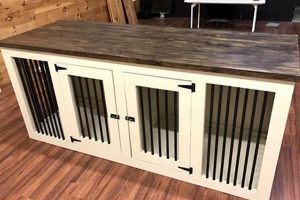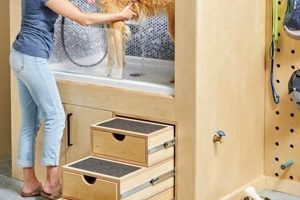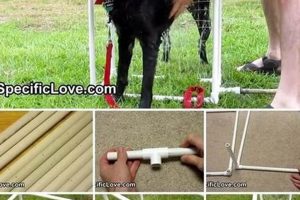A self-constructed canine shelter equipped with a heating element offers a customized solution for pet owners seeking to provide warmth and protection for their dogs during colder seasons. These structures range in complexity, from simple insulated boxes to elaborate designs incorporating thermostats and safety features. An example would be a wooden enclosure built to specific dimensions for the dog, insulated with foam, and fitted with a low-wattage, pet-safe heating pad.
The provision of a heated outdoor refuge contributes significantly to a dog’s well-being, especially in regions with harsh winters. It allows dogs to spend time outdoors comfortably, reducing potential behavioral issues stemming from confinement. Historically, providing adequate shelter for working dogs, particularly those kept outside, was a common practice; adapting and improving upon traditional designs with modern heating technology represents a continuation of this concern for animal welfare. Benefits include protection from hypothermia, improved comfort, and reduced stress on the animal’s immune system.
Subsequent sections will delve into considerations for design and construction, appropriate heating elements, safety measures, and potential cost savings associated with creating a tailored canine shelter. Detailed information on material selection, insulation techniques, and power source options will also be presented.
Tips for Building a Heated Canine Shelter
Constructing a durable and safe heated shelter requires careful planning and execution. The following guidelines are designed to optimize the project’s success and ensure the animal’s safety and comfort.
Tip 1: Design for Adequate Space: Ensure the internal dimensions accommodate the dog’s size comfortably. The structure should allow the dog to stand, turn around, and lie down without obstruction, preventing unnecessary joint strain or discomfort.
Tip 2: Select Durable, Weather-Resistant Materials: Opt for rot-resistant wood, such as cedar or treated lumber, for the frame. Consider using roofing shingles or a waterproof membrane to protect against rain and snow infiltration. This minimizes long-term maintenance and potential health hazards.
Tip 3: Employ Effective Insulation Techniques: Incorporate rigid foam insulation within the walls, floor, and roof. Properly sealed seams prevent drafts and heat loss, improving energy efficiency and maintaining a consistent internal temperature.
Tip 4: Prioritize Electrical Safety: Utilize ground fault circuit interrupters (GFCIs) to protect against electrical shock. Use outdoor-rated extension cords and ensure all wiring is properly insulated and protected from chewing or water damage.
Tip 5: Choose a Safe and Appropriate Heating Element: Select a low-wattage, pet-safe heating pad or a radiant heat panel designed for animal use. Avoid using space heaters, as they can pose a burn hazard or create uneven temperature distribution.
Tip 6: Incorporate Ventilation: Include small vents near the roofline to allow for air circulation. This prevents moisture buildup and reduces the risk of respiratory problems.
Tip 7: Provide a Raised Floor: Elevate the floor slightly off the ground using supports or a pallet. This prevents moisture from seeping in and provides an additional layer of insulation against the cold ground.
Following these guidelines will contribute to a long-lasting, safe, and comfortable heated environment for the dog, minimizing risks and maximizing the structure’s effectiveness. Consistent monitoring of the internal temperature and the dog’s behavior is crucial for maintaining optimal conditions.
The next section will address the practical considerations of cost-effectiveness and energy efficiency in the design and operation of a custom-built, climate-controlled canine habitat.
1. Size
The dimensions of a self-constructed canine shelter with integrated heating directly influence its effectiveness and the animal’s comfort. An undersized structure restricts movement, potentially causing discomfort and hindering the dog’s ability to regulate its body temperature effectively. Conversely, an excessively large enclosure reduces the efficiency of the heating system, as more energy is required to warm a greater volume of space. This can lead to higher energy consumption and potentially inadequate warmth, especially during periods of extreme cold. Real-world examples demonstrate that precisely measured shelters, conforming to the dog’s breed and individual size, provide optimal thermal performance and creature comfort.
The importance of appropriate sizing extends beyond mere comfort. An appropriately sized shelter encourages the dog to utilize it regularly, providing consistent protection from the elements. If the enclosure is either too cramped or too expansive, the dog may be less inclined to use it, negating the benefits of the integrated heating system. Furthermore, an accurately sized space simplifies the task of maintaining a stable and consistent internal temperature, allowing the heating element to operate more efficiently. For instance, a small terrier housed in a structure designed for a large breed may experience temperature fluctuations and drafts, diminishing the effectiveness of the heater.
In summary, the connection between size and a custom-built, heated canine shelter is paramount. An accurately sized structure maximizes comfort, promotes consistent usage, enhances heating efficiency, and ultimately provides the best protection from the elements. Challenges arise in accurately measuring and accommodating for growth, particularly in puppies, but careful consideration of these factors is crucial for a successful and beneficial outcome.
2. Insulation
Insulation is a critical component in the design and construction of a self-built, heated canine shelter, directly impacting its energy efficiency, temperature regulation, and overall effectiveness. Without adequate insulation, the benefits of a heating system are significantly diminished, as heat loss negates the intended warming effect. Properly implemented insulation minimizes heat transfer, maintaining a stable and comfortable internal environment for the animal.
- Material Selection and R-Value
The choice of insulation material, defined by its R-value (resistance to heat flow), dictates the insulation’s effectiveness. Higher R-values indicate better insulating properties. Rigid foam boards, such as expanded polystyrene (EPS) or extruded polystyrene (XPS), are commonly employed due to their high R-values, moisture resistance, and ease of installation. Fiberglass batting, while less expensive, is less resistant to moisture and compression, potentially reducing its insulating capacity over time. The selection of an appropriate material with a suitable R-value is crucial for minimizing heat loss and maintaining a consistent temperature within the shelter.
- Proper Sealing and Air Gap Minimization
Effective insulation requires not only selecting the appropriate material but also ensuring proper sealing of all seams and joints. Air gaps and cracks allow for significant heat loss through convection and infiltration. Expanding foam, caulk, and weather stripping are essential tools for sealing gaps around doors, windows (if included), and where insulation panels meet. Minimizing air gaps maximizes the effectiveness of the insulation and reduces the energy demand of the heating system. A real-world example would be meticulously sealing the perimeter of insulation panels within the walls to prevent cold air from seeping in during winter months.
- Floor Insulation and Ground Contact
Heat loss through the floor of the shelter is often overlooked. Direct contact with the cold ground can significantly reduce the effectiveness of the overall insulation system. Elevating the structure off the ground using supports or a pallet creates an air gap that minimizes heat transfer. Additionally, insulating the floor with rigid foam or other suitable material further reduces heat loss to the ground. This combination of elevation and insulation provides a more consistent internal temperature and reduces the energy required to maintain a comfortable environment.
- Insulation Thickness and Climate Considerations
The optimal thickness of insulation depends on the local climate and the severity of winter temperatures. Regions with harsh winters require thicker insulation to maintain a stable internal temperature. General guidelines suggest a minimum R-value of R-13 for walls and R-19 for the roof in colder climates. Consulting local building codes and insulation guidelines can provide specific recommendations for the region. Increasing the insulation thickness improves energy efficiency and ensures the heating system can effectively maintain a comfortable environment for the dog, even during periods of extreme cold. A real-life example is the use of thicker insulation in self-built shelters in regions like Alaska, where sub-zero temperatures are common.
The successful implementation of insulation in a custom-built, heated canine shelter is dependent on material selection, proper sealing, attention to floor insulation, and consideration of climate-specific requirements. These facets work in concert to minimize heat loss, reduce energy consumption, and provide a consistently warm and comfortable environment for the animal. The absence of any one of these facets can significantly reduce the effectiveness of the overall system, highlighting the importance of a comprehensive approach to insulation design and installation.
3. Ventilation
In the context of a self-constructed canine shelter incorporating a heating element, ventilation plays a crucial, albeit often overlooked, role. While the primary objective is to maintain a warm environment, adequate ventilation is essential to prevent the buildup of moisture and condensation within the structure. The animal’s respiration, combined with potential moisture from the surrounding environment, can lead to elevated humidity levels, creating a breeding ground for mold and bacteria. This can negatively impact the dog’s respiratory health and overall well-being, counteracting the intended benefits of the heated shelter. Insufficient airflow, therefore, transforms a potentially beneficial structure into a health hazard. A real-world example is a sealed, insulated shelter lacking ventilation, where condensation forms on the interior surfaces, leading to a damp and unhealthy environment for the dog.
The integration of ventilation into the design necessitates a balanced approach. Excessive ventilation can compromise the heating system’s efficiency, resulting in heat loss and increased energy consumption. Therefore, the ventilation system should be designed to provide a controlled exchange of air, removing moisture without significantly reducing the internal temperature. This can be achieved through the use of small, strategically placed vents near the roofline or through the incorporation of a baffled ventilation system. These designs allow for air circulation while minimizing drafts and heat loss. For example, a small vent on each side of the roof, angled inward, can facilitate airflow while preventing direct wind exposure. Furthermore, the size and number of vents should be adjusted based on the size of the shelter and the climate conditions.
In summary, ventilation is not merely an ancillary consideration but an integral component of a self-constructed, heated canine shelter. Its proper implementation mitigates the risk of moisture buildup and associated health problems, while its careful design ensures minimal impact on the heating system’s efficiency. Challenges arise in determining the optimal ventilation rate, but prioritizing a balanced approach contributes significantly to the animal’s comfort and long-term health. The interconnection between heating and ventilation underscores the necessity of a holistic design perspective when constructing a climate-controlled canine environment.
4. Heating
The “heating” component is intrinsically linked to the concept of a self-constructed canine shelter, functioning as the core element that transforms a basic enclosure into a climate-controlled environment. The provision of warmth directly addresses the vulnerability of dogs to hypothermia, particularly during periods of low ambient temperatures. Without a reliable heating source, a shelter, even one well-insulated, can fail to provide adequate protection from the elements. The effect is most pronounced in smaller breeds, short-haired dogs, and elderly or ill animals, which possess reduced capacity for thermoregulation. For example, a Dachshund, with its low body profile, is inherently more susceptible to ground-level cold and benefits significantly from a heated shelter, which mitigates the risk of cold-related health complications. The integration of “heating” is not merely an optional feature; it is a critical factor determining the effectiveness and the overall purpose of the self-constructed shelter.
The practical application of “heating” within a canine shelter extends beyond simple temperature elevation. The type of heating element, its power consumption, and its safety features are all critical design considerations. Low-wattage heating pads designed specifically for pets are often preferred, as they provide a consistent and localized source of warmth without posing a significant burn risk. Thermostatically controlled heating elements offer an additional layer of safety and efficiency, allowing for the maintenance of a stable temperature range and preventing overheating. A shelter situated in a region with fluctuating temperatures would benefit from a thermostatically controlled heating system, which automatically adjusts the heat output to maintain a consistent internal environment, irrespective of external conditions.
In summary, the presence of a reliable and safe “heating” system is paramount to the functionality and purpose of a self-constructed canine shelter. Careful selection of the heating element, coupled with appropriate temperature control and safety measures, ensures the animal’s well-being and prevents potential hazards. The challenges of balancing energy efficiency with adequate warmth necessitate a thorough understanding of heating principles and the specific needs of the canine occupant. The heating element, therefore, represents the central functional component that transforms a basic shelter into a climate-controlled refuge, directly contributing to the animal’s health and comfort.
5. Safety
Safety constitutes a paramount consideration in the design and construction of any self-built canine shelter incorporating a heating element. The potential for electrical hazards, fire risks, and other injuries necessitates meticulous attention to detail throughout the planning and execution phases.
- Electrical Wiring and Grounding
Improperly installed or maintained electrical wiring presents a significant risk of electrical shock. The use of outdoor-rated wiring, waterproof connectors, and ground fault circuit interrupters (GFCIs) is essential to minimize this risk. All wiring should be securely routed and protected from chewing or physical damage. Real-world examples include the use of flexible metal conduit to protect wiring and the installation of GFCIs to prevent electrocution in the event of a fault. Failure to adhere to these precautions can result in serious injury or death to the animal.
- Heating Element Selection and Placement
The selection of an appropriate heating element is crucial for preventing burns and overheating. Low-wattage heating pads designed specifically for pets are generally considered safer than space heaters, which can pose a fire hazard. The heating element should be placed in a location where the animal cannot directly chew on it or become entangled in its cord. Incorporating a thermostat to regulate the temperature further reduces the risk of overheating. An instance of poor practice is the use of a standard household heating pad, which may not be designed for continuous use and could overheat, leading to burns. Proper selection and placement mitigate these dangers.
- Material Toxicity and Fire Resistance
The materials used in the construction of the shelter should be non-toxic and fire-resistant. Treated lumber, while providing weather resistance, may contain chemicals that can be harmful if ingested. Untreated cedar or redwood offer a safer alternative. Insulation materials should also be selected for their fire-resistant properties. The use of readily combustible materials, such as untreated plywood or flammable insulation, increases the risk of fire. The implementation of fire-retardant coatings and the selection of inherently fire-resistant materials enhance the overall safety of the structure.
- Ventilation and Air Quality
Adequate ventilation is essential to prevent the buildup of carbon monoxide or other harmful gases, especially if the heating element is not electrically powered. Stagnant air can also contribute to the growth of mold and bacteria, leading to respiratory problems. Strategically placed vents allow for air circulation without compromising the shelter’s ability to retain heat. The absence of ventilation can create a toxic environment, particularly if a malfunctioning heating element releases harmful byproducts. The presence of properly designed ventilation ensures a safe and healthy air quality within the shelter.
These safety facets underscore the importance of meticulous planning and execution in the construction of a self-built, heated canine shelter. Neglecting these considerations can lead to severe consequences for the animal. The integration of safety measures is not merely a matter of compliance; it is a fundamental ethical obligation to ensure the well-being of the animal for which the shelter is intended. Diligence and adherence to safety protocols mitigate risks and contribute to a safe and comfortable environment.
6. Durability
The enduring quality of a self-constructed canine shelter integrating a heating system is of paramount importance. The structure is exposed to external environmental factors, including precipitation, temperature fluctuations, and potential physical damage from the animal itself. Consequently, the longevity and continued functionality of the shelter depend on the selection of appropriate materials and construction techniques that ensure structural integrity and resistance to degradation over time.
- Material Selection and Weather Resistance
The choice of construction materials directly influences the shelter’s ability to withstand environmental stressors. Untreated wood is susceptible to rot and insect infestation, while pressure-treated lumber offers enhanced resistance but may contain chemicals that can leach into the surrounding environment. Composite materials or naturally decay-resistant woods, such as cedar or redwood, represent viable alternatives. Roofing materials, such as asphalt shingles or metal panels, protect the underlying structure from water damage and UV exposure. An instance of poor material selection is the use of thin plywood, which can warp and delaminate when exposed to moisture. Proper material selection is a prerequisite for long-term durability.
- Structural Integrity and Joint Construction
The structural design and the methods used to join the various components determine the shelter’s ability to withstand physical stresses. Weak joints or inadequate framing can lead to structural failure under the weight of snow or from the activity of the animal. Reinforcing corners with metal brackets, using screws instead of nails, and ensuring proper alignment of framing members enhance the overall structural integrity. A poorly constructed shelter, with improperly secured joints, is prone to collapse or deformation, reducing its lifespan and potentially endangering the animal. Robust construction techniques are, therefore, essential for maintaining structural stability.
- Protection Against Animal-Induced Damage
Canines may exhibit chewing or scratching behaviors that can compromise the integrity of the shelter. Exposed edges of wood, unprotected wiring, and easily detachable components are vulnerable to damage. Encasing wiring in conduit, reinforcing edges with metal strips, and using durable fasteners to secure components prevent animal-induced degradation. For example, covering exposed insulation with a chew-resistant material prevents the animal from ingesting potentially harmful substances. Protecting the structure from the animal’s natural behaviors extends its lifespan and ensures continued functionality.
- Maintenance and Preventative Measures
Regular maintenance is crucial for preserving the durability of a self-constructed canine shelter. Inspecting the structure for signs of damage, repairing any defects promptly, and applying protective coatings extend its lifespan. Caulking seams, replacing damaged roofing materials, and treating wood with preservatives are examples of preventative measures. A neglected shelter, left unrepaired, will deteriorate rapidly, reducing its ability to provide adequate protection. Consistent maintenance preserves structural integrity and ensures the long-term effectiveness of the heated shelter.
The enduring nature of a custom-built heated canine shelter is a multifaceted attribute influenced by material selection, construction techniques, protection against animal damage, and consistent maintenance. Each of these aspects contributes to the overall lifespan of the structure, ensuring that it provides continued protection and comfort for the animal. By prioritizing durability, the owner maximizes the return on investment and minimizes the need for frequent repairs or replacements.
7. Placement
Strategic positioning of a self-constructed canine shelter equipped with a heating element is critical to optimizing its functionality and ensuring the animal’s comfort. The location directly influences the shelter’s exposure to environmental elements, its accessibility for the dog, and its overall effectiveness in providing a safe and comfortable refuge.
- Protection from Prevailing Winds
Shelter placement should prioritize protection from prevailing winds. Direct exposure to strong winds can significantly reduce the effectiveness of the heating system, as cold air infiltration increases heat loss. Positioning the structure against a building, fence, or natural windbreak mitigates this effect. For instance, placing the entrance facing away from the typical wind direction minimizes drafts and maintains a more stable internal temperature. Failure to consider wind direction can negate the benefits of insulation and heating, leading to increased energy consumption and reduced animal comfort.
- Sun Exposure and Shade
The amount of sun exposure the shelter receives impacts its internal temperature, particularly during transitional seasons. In winter, maximizing sun exposure can supplement the heating system and reduce energy consumption. Conversely, during warmer months, providing shade is essential to prevent overheating. Placement beneath a deciduous tree provides natural shade during summer while allowing sunlight to penetrate in winter after the leaves have fallen. Orienting the shelter with an overhang can also provide shade during the hottest parts of the day. A location with excessive sun exposure can render the shelter uninhabitable during warmer periods, even if it is well-ventilated.
- Accessibility and Proximity to the Residence
The shelter should be easily accessible to the dog and located in close proximity to the residence. This encourages the animal to use the shelter regularly and allows for convenient monitoring of its condition. Placing the shelter in a secluded area may discourage its use, particularly by older or less mobile dogs. Proximity to the residence also facilitates easier access for cleaning and maintenance. A shelter located too far from the house may be neglected, leading to unsanitary conditions and potential health hazards.
- Ground Conditions and Drainage
The ground conditions surrounding the shelter should be well-drained to prevent moisture buildup and promote a dry and sanitary environment. Placing the structure on a slightly elevated surface or providing drainage around its perimeter minimizes the risk of water accumulation. Damp conditions can lead to mold growth and contribute to respiratory problems. A location with poor drainage can render the shelter unusable during periods of heavy rainfall, negating its purpose as a protective refuge.
Considering these placement facets ensures that a self-constructed heated canine shelter provides optimal protection and comfort. By carefully evaluating wind exposure, sun orientation, accessibility, and ground conditions, the owner can maximize the effectiveness of the heating system and create a safe and inviting environment for the animal. The interconnection of placement with the shelter’s design and functionality underscores the importance of a holistic approach to canine shelter construction.
Frequently Asked Questions
The following addresses common inquiries regarding the construction, operation, and safety of self-built canine shelters featuring integrated heating systems. The information provided is intended to offer guidance and should not substitute professional advice.
Question 1: What is the appropriate level of insulation for a heated dog house in a region with consistently sub-freezing temperatures?
Insulation requirements vary depending on specific climate conditions. However, a minimum R-value of R-13 for walls and R-19 for the roof is generally recommended in regions experiencing prolonged periods of sub-freezing temperatures. Local building codes may provide more specific guidance.
Question 2: What type of heating element is considered safest for a canine shelter?
Low-wattage, pet-safe heating pads or radiant heat panels specifically designed for animal use are generally considered the safest options. Avoid using space heaters or heat lamps, as they pose a significant burn hazard.
Question 3: How can the risk of electrical shock be minimized in a DIY heated dog house?
The use of ground fault circuit interrupters (GFCIs) is essential to protect against electrical shock. Outdoor-rated wiring and waterproof connectors should also be employed, and all wiring should be protected from chewing or water damage.
Question 4: What is the optimal placement for ventilation openings in a heated canine shelter?
Small vents near the roofline, positioned to minimize direct wind exposure, are generally recommended. These vents should allow for air circulation without causing excessive heat loss.
Question 5: What materials are recommended for constructing a durable and weather-resistant heated dog house?
Rot-resistant wood, such as cedar or treated lumber, is recommended for the frame. Roofing shingles or a waterproof membrane should be used to protect against rain and snow. The use of durable fasteners and reinforced joints is also essential.
Question 6: How can the internal temperature of a heated dog house be effectively monitored?
An inexpensive indoor/outdoor thermometer can be placed inside the shelter to monitor the temperature. Regular checks are recommended to ensure the temperature remains within a safe and comfortable range for the animal.
The information presented addresses key concerns regarding the construction and safe operation of a self-made heated canine shelter. Proper planning and adherence to safety guidelines are essential for ensuring the animal’s well-being.
The subsequent section will explore case studies and examples of successful self-constructed heated canine shelters, providing practical insights and inspiration for prospective builders.
DIY Dog House with Heater
This exposition has detailed the critical aspects of constructing a “diy dog house with heater,” encompassing design considerations, material selection, safety protocols, and practical implementation. It emphasized the interplay between adequate insulation, controlled ventilation, appropriate heating elements, and strategic placement. Furthermore, it underscored the importance of selecting durable, non-toxic materials and prioritizing the animal’s well-being throughout the construction process.
The provision of a secure and thermally regulated outdoor refuge represents a significant commitment to canine welfare. Careful consideration of the factors outlined herein will contribute to the creation of a safe, comfortable, and enduring shelter, ensuring the animal’s protection from the elements. Further research and adherence to local building codes are encouraged to optimize the design and functionality of such structures.







